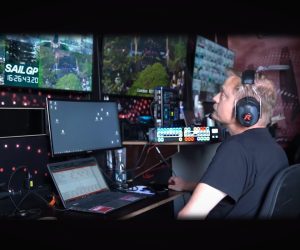
RIEDEL ENABLES MULTI-SITE LINKING AT AZUSA UNIVERSITY

Azusa Pacific University (APU) is an evangelical Christian university located 26 miles northeast of Los Angeles. It recently purchased four new Riedel MediorNet MicroN 80G media distribution network devices that enable the university to link sites across its Azusa, California, campus in a decentralised routing matrix. Complementing APU’s existing MediorNet Modular real-time media network, Artist digital matrix intercom, and RockNet digital audio network systems, the MicroN devices support uniquely flexible and easy-to-manage signal processing, routing, and distribution.
“Riedel’s systems are an integral part of supporting the massive quantity and variety of productions that occur at the various Azusa Pacific venues — sports broadcasts, concerts, broadcast journalism programs, corporate events, galas, and more,” said Erik Mahoney, Broadcast/Production Systems Engineer for IMT Media Services at APU. “The Artist, RockNet, and MediorNet systems have allowed us to bring the separate venues together into one cohesive production environment in which all our communications, audio, video, and more can be easily routed and utilised anywhere on campus. The flexibility and ease of configuration, not to mention Riedel’s rock-solid reliability, have allowed us to do more frequent and more complex productions than ever before.”

Deploying multiple interconnected MicroN units over the course of just four hours, APU created a decentralised routing system that distributes signal load, takes advantage of flexible node placement, and eliminates any single point of failure. The university has installed four MediorNet MicroN units in the control room at the Turner Lynch Campus Center, located at APU’s main campus in Azusa. This control room serves a variety of production spaces throughout the campus that host high-profile corporate events, TEDx Talks, sports broadcasts, special lecture capture/streaming, concerts, the university’s commencement ceremonies, and chapel worship services held across multiple sites.
With on-board signal processing capabilities including frame synchronisation, embedding/de-embedding, and delays, the MicroN-based solution can handle SDI signals in a versatile, and scalable routing solution. Built-in processing has not only eliminated the need to purchase and support separate processing cards and hardware, but also helps to conserve rack space. It also means APU can easily extend the router in both signal capacity and distributed system locations with further MicroN nodes as needed.

“When we made the decision to replace our old 40 x 40 HD-SDI router, MicroN was the clear choice,” added Mahoney. “Using MicroN as our router, we’ve been able to eliminate layers upon layers of interconnected routers and signal transport systems and simply work with one MediorNet system that does it all, including built-in signal processing. As the needs of the university and our clients increase and evolve, we can easily add additional units — wherever they are physically needed — to increase our I/O. Because MicroN will integrate easily into 4K and IP workflows, we know that we are making a sound investment for both today’s needs and the needs future broadcast technology will bring. In the several months we have had MicroN, performance has been flawless, and we haven’t had a single instance where we were able to point to a ‘traditional’ router and say, ‘Yeah, that did that better.'”
More Info:
Riedel: www.riedel.net















RESPONSES